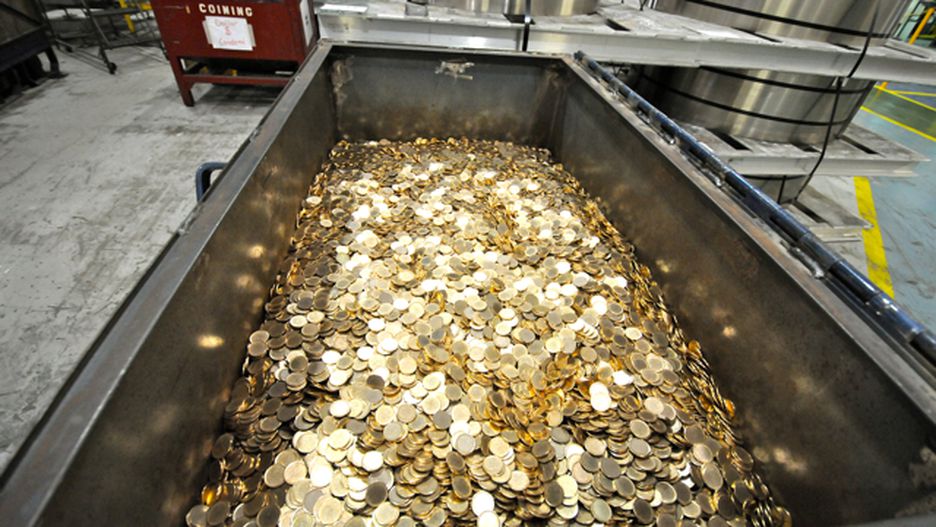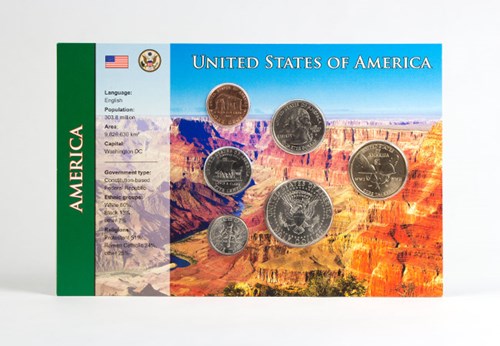World coins
Five Fun Facts about US coins for American Independence Day!
Today is American Independence Day and we thought there could be no better way to join in the 4th of July celebrations than to share five fun facts you might not know about US coinage!
1) The reverses are struck upside down.
Did you know that on US coins, the reverses are stuck upside down? This is arguably due to the fact that originally, the Mint wanted to differentiate their coins from their medals. The medals’ faces are struck with the same orientation as they are supposed to be worn, and therefore when rotated, still show an upright image.

Upside down reverses. Credit: coincommunity.com
2) By law, US coin designs must give “an impression emblematic of liberty.”
The USA, as a nation, are well known for being one of the most patriotic countries in the world. They uphold strong values of liberty and freedom, from everyday life to sporting events and even on their coinage! As a result of this, US coin designers are legally required to display an impression emblematic of liberty in their coin designs.

Statue of Liberty, a true symbol of patriotism.
3) The coinage act of 1792, establishing the U.S. Mint, made defacing, counterfeiting, or embezzling of coins by Mint employees punishable by death.
The death penalty is still legal in 31 US states and the coinage act of 1792 is still in place today. This states that any Mint employee caught defacing, counterfeiting or embezzling coins can be, in theory, sentenced to death. Whether or not this would be upheld in today’s court of law is debatable.

Defaced coin. Credit: pinterest.co.uk/crumley1065/the-coin-box
4) Origin of the “buck”.
This well-known slang term for an American dollar is thought to have originated in the early US frontier days when the hide of a male deer (a buck) was common currency, due to the scarcity of coinage. The term has since been adopted into everyday language and certainly seems to be here to stay for a while!

Buck. Credit: state.nj.us
5) The U.S. Mint’s coin production has grown over 131,000,000% since production first started in 1793.
The US Mint’s operation has grown and advanced greatly since the first mintage in 1972, when production consisted of 11,178 copper cents. Today the Mint produces an average of 14.7 million coins per day. The first mint in Philadelphia actually used horses to drive the machinery, whereas today, much more modern techniques are used and greater numbers of coins can be produced.

So there we have it, five fun facts about US coinage! Whether they come in handy at your next quiz night, give you something interesting to bring up in conversation, or even spark your interest in collecting US coins, we hope you’ve enjoyed finding out more about US coins.
Own the US Coin Pack today!
If this has sparked your interest in US coins, why not own the coin pack containing 6 US coins from the 1 Cent to the 1 Dollar? Each coin is protectively encapsulated in display packaging with an image of the iconic Grand Canyon and additional information about the USA and their coinage.
World Coin of the Year winners announced
At the recent World Money Fair held in Berlin, Germany, ‘The Coin of the Year’ (sponsored by World Coin News) winners were announced.
First held back in 1984, the awards are designed to, “…recognise the best of the coiner’s art and to encourage world mints to continue to challenge themselves in creating these great numismatic works.”
It’s safe to say that some of the winning coins are spectacular! I hope you enjoy looking through this range of amazing coin designs, don’t forget to let us know which is your favourite!
Best Circulating Coin

China Banknote Printing and Minting, 10 Yuan, Bi-Metallic. “Year of the Monkey” (Image: Numismatic News)
Most Inspirational Coin

Royal Canadian Mint, 20 Dollars, Silver. “Mother Earth”. (Image: Numismatic News)
Best Bi-Metallic Coin

Austrian Mint, 25 Euro, Bi-Metallic Niobium Silver. “Time”. (Image: Numismatic News)
Most Artistic Coin

Bank of Latvia, 5 Euro, Silver. “National Entrepreneur”. (Image: Numismatic News)
Most Innovative Coin

German Federal Ministry of Finance, 5 Euro, Copper-Nickel. “Planet Earth”. (Image: Numismatic News)
It’s not just UK coins that could turn up in your change…
Coins from Crown dependencies and overseas British territories can sometimes make an unexpected appearance in our change.
They are identical in size, shape and weight to UK denominations which means they often find their way into tills and vending machines undetected.
Finding one in your change can be an annoyance on one hand as technically the coins are not legal tender in the UK. On the other hand, from a collecting point of view, new and interesting designs are always a bonus!
Here’s a look at our top 5 favourite coin designs that have been issued by Crown dependencies and overseas British territories since decimalisation:

Guernsey Freesia Flowers 50p’s were only issued in sets in 1985, 1986, 1987, 1988, 1989, 1990 and 1992. They were issued into circulation in 1997.
This beautiful 50p from Guernsey features two crossed freesia flowers with ‘FIFTY PENCE’ and the date at the top and ’50’ below the design.
The obverse features David Maklouf’s portrait of Queen Elizabeth II with the lettering ‘Bailiwick of Guernsey’ above, and also a small Guernsey Coat of Arms to the left.
This addition on the obverse makes the Guernsey 50p stand out when compared to UK 50p coins.
This 50p has the pre-1997 specifications.
Guernsey Lily £1 Coin

Guernsey Lily £1 issued in 1981.
The Guernsey Lily £1 features the island’s Lily on the reverse, and the Guernsey Coat of Arms on the obverse.
This unusual obverse without the Queen’s head makes this particular coin stand out amongst other £1 coins, and makes it sought after by collectors.
Along with the UK, Guernsey withdrew their round £1 coins from circulation in October 2017.
Isle of Man Tower of Refuge £2

Isle of Man Tower of Refuge £2 issued in 2017.
The Tower of Refuge is an important landmark on the Isle of Man. It was built in 1832 upon the reef on orders of Sir William Hillary, founder of the Royal National Lifeboat Institution.
The impressive tower with birds flying above it features on the reverse of this Isle of Man £2 coin. The obverse carries a new effigy of Her Majesty Queen Elizabeth II by Jody Clark, this effigy being reserved for the Crown dependencies and Commonwealth countries.
Gibraltar Candytuft Flowers 50p

The Gibraltar Candy Tuft Flowers 50p issued in 1988 is 7 times rarer than the 2009 Kew Gardens 50p.
This 50p features the denomination surrounded by a crown of Gibraltar Candytuft flowers, known as ‘Iberis Gibraltarica’.
Iberis Gibraltarica is the national flower of Gibraltar and is the symbol of the Upper Rock Nature Reserve which covers 40% of the country’s land area. Gibraltar is the only place in Europe where it is found growing in the wild.
With a mintage of just 30,000 in 1988, this 50p is 7 times rarer than the UK’s rarest 50p so is particularly scarce and sought after amongst collectors. This 50p has the pre-1997 specifications.
Jersey Resolute £1

The Jersey Resolute £1 was issued in 1994, 1997,1998, 2003, 2005 and 2006.
The Resolute vessel was built in 1877 in Jersey by Thomas Le Huguet and was owned by Captain George Noel. The ship was used for trade before it was wrecked during a hurricane on 29th August 1905 at Friars Cove off Newfoundland.
The design depicts a two-mastered topsail schooner Resolute ship and was first issued into circulation in Jersey in 1994.
To ensure their currency would not be left vulnerable to counterfeiters, Jersey withdrew their round £1 coins from circulation in October 2017.
So have you come across any of these coin designs in your change or do you already collect coins from other countries? Let us know via Facebook, Twitter or Instagram or leave us a comment below.
With a much lower population than the UK, some of these coins that can be found in your change can be extremely rare, so it’s worth keeping hold of them.

